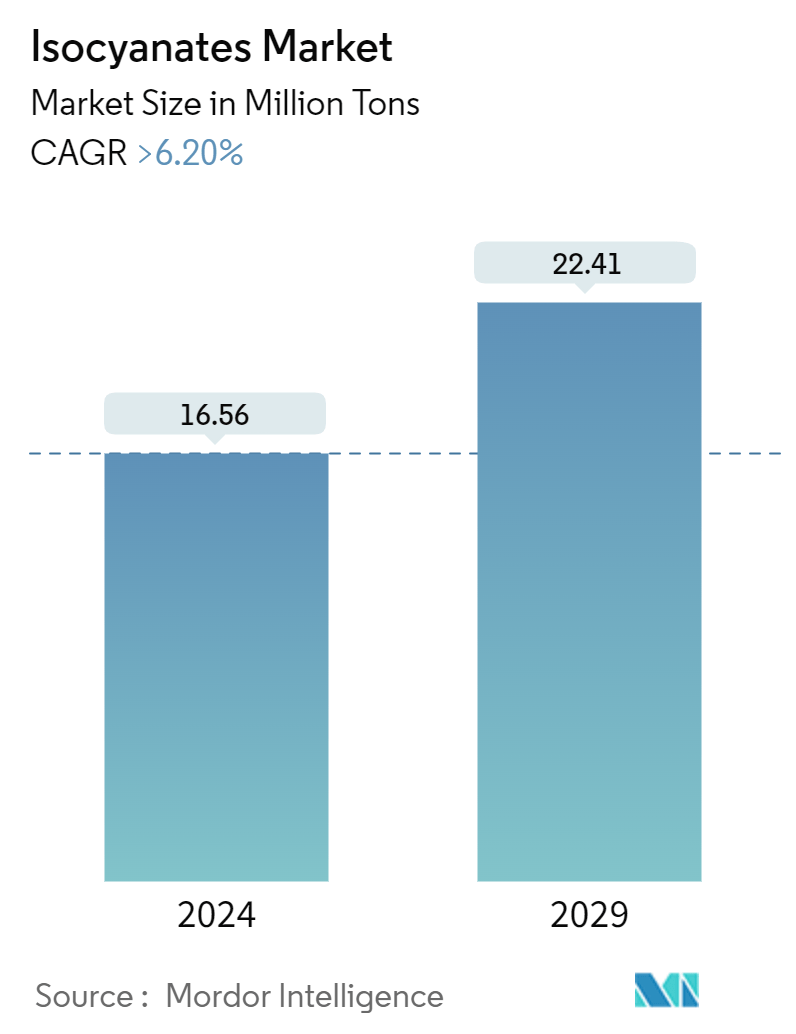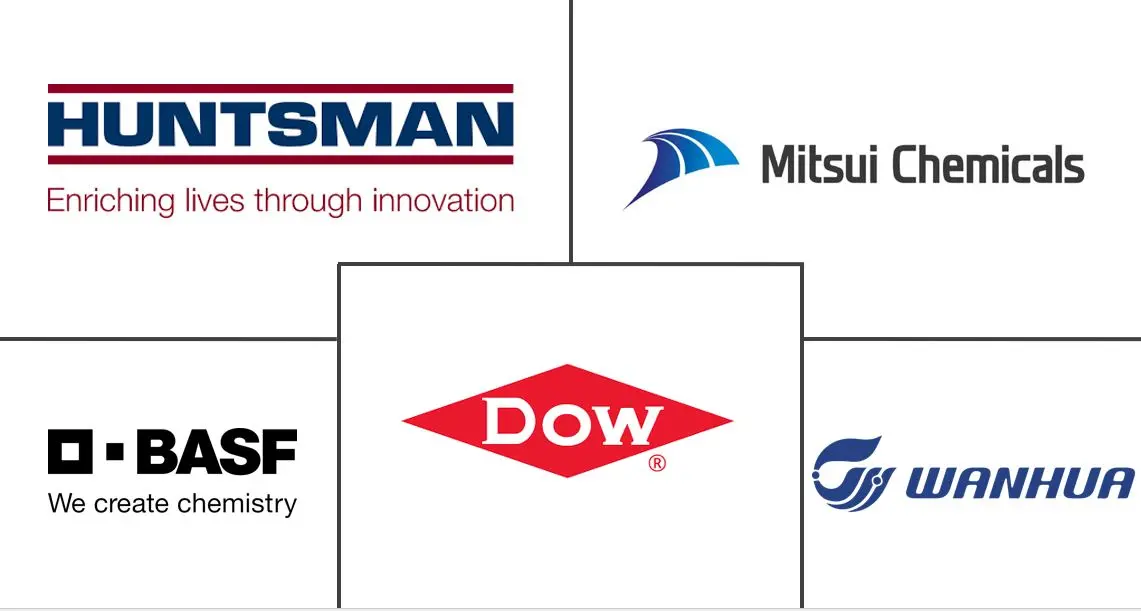Market Size of Isocyanates Industry

| Study Period | 2019 - 2029 |
| Market Volume (2024) | 16.56 Million tons |
| Market Volume (2029) | 22.41 Million tons |
| CAGR (2024 - 2029) | > 6.20 % |
| Fastest Growing Market | Asia Pacific |
| Largest Market | Asia Pacific |
| Market Concentration | Low |
Major Players
*Disclaimer: Major Players sorted in no particular order |
Isocyanates Market Analysis
The Isocyanates Market size is estimated at 16.56 Million tons in 2024, and is expected to reach 22.41 Million tons by 2029, growing at a CAGR of greater than 6.20% during the forecast period (2024-2029).
- Over the medium term, factors like growing applications of polyurethane foam, growing industrialization in Asia-Pacific, and growing demand from the construction industry are propelling the demand in the market studied.
- However, shortages and increased prices of raw materials are likely to restrain the market's growth.
- Growing investments by manufacturers in R&D activities and the high efficiency of bio-based isocyanates are expected to create opportunities for market growth in the future.
- Due to increased industrialization, Asia-Pacific dominated the isocyanates market, which is likely to witness a high growth rate during the forecast period.
Isocyanates Industry Segmentation
A family of compounds with low molecular weight and high reactivity is known as isocyanates. These chemicals, characterized by the isocyanate group (-NCO), react with alcohol (hydroxyl) groups to produce polyurethane polymers.
The isocyanates market is segmented into type, application, end-user industry, and geography. By type, the market is segmented into MDI, TDI, aliphatic, and other types. By application, the market is segmented into rigid foam, flexible foam, paints and coatings, adhesives and sealants, elastomers, binders, and other applications. By end-user industry, the market is segmented into building and construction, automotive, healthcare, furniture, and other end-user industries. The report also covers the market size and forecasts for the isocyanates market in 27 countries across major regions. The market sizing and forecasts for each segment are provided based on volume (kilotons).
| By Type | |
| MDI | |
| TDI | |
| Aliphatic | |
| Other Types |
| By Application | |
| Rigid Foam | |
| Flexible Foam | |
| Paints & Coatings | |
| Adhesives & Sealants | |
| Elastomers | |
| Binders | |
| Other Applications |
| By End-user Industry | |
| Building and Construction | |
| Automotive | |
| Healthcare | |
| Furniture | |
| Other End-user Industries (Aerospace, Electronics, Water Vessels, etc.) |
| By Geography | |||||||||||
| |||||||||||
| |||||||||||
| |||||||||||
| |||||||||||
|
Isocyanates Market Size Summary
The isocyanates market is poised for significant growth, driven by the expanding application of polyurethane foams, particularly in the building and construction sector. This sector remains the largest end-user, utilizing isocyanates for various applications such as insulation, insulated panels, and gap fillers. The push towards zero-energy buildings is a major factor propelling the demand for polyurethane, and consequently, isocyanates. Despite challenges like raw material shortages and price increases, the market is expected to benefit from the high efficiency of bio-based isocyanates. The Asia-Pacific region, led by China, is a dominant force in the market due to rapid industrialization and substantial infrastructure investments, with countries like India and Japan also contributing to the growth through increased demand in construction, automotive, and furniture industries.
The market landscape is partly consolidated, with key players such as Dow, BASF SE, Evonik Industries, Tosoh Corporation, and Mitsui Chemicals, Inc. holding significant shares. Recent developments include BASF's expansion of its methylene diphenyl diisocyanate (MDI) plant in Louisiana and the introduction of environmentally friendly products like Lupranat ZERO. The market's growth trajectory is supported by ongoing infrastructure projects and the rising demand for polyurethane products across various industries, ensuring a robust outlook for isocyanates in the coming years.
Isocyanates Market Size - Table of Contents
-
1. MARKET DYNAMICS
-
1.1 Drivers
-
1.1.1 Huge Growth in the Polyurethane Foam Application
-
1.1.2 Increase in Industrialization Activities in Asia-Pacific
-
1.1.3 Increasing Demand from the Construction Industry
-
-
1.2 Restraints
-
1.2.1 Shortage and Increased Price of Raw Material
-
1.2.2 Hazardous in Nature
-
-
1.3 Industry Value-Chain Analysis
-
1.4 Porter's Five Forces Analysis
-
1.4.1 Bargaining Power of Suppliers
-
1.4.2 Bargaining Power of Consumers
-
1.4.3 Threat of New Entrants
-
1.4.4 Threat of Substitute Products and Services
-
1.4.5 Degree of Competition
-
-
1.5 Price Trend
-
1.6 Regulatory Policy Analysis
-
-
2. MARKET SEGMENTATION (Market Size in Volume)
-
2.1 By Type
-
2.1.1 MDI
-
2.1.2 TDI
-
2.1.3 Aliphatic
-
2.1.4 Other Types
-
-
2.2 By Application
-
2.2.1 Rigid Foam
-
2.2.2 Flexible Foam
-
2.2.3 Paints & Coatings
-
2.2.4 Adhesives & Sealants
-
2.2.5 Elastomers
-
2.2.6 Binders
-
2.2.7 Other Applications
-
-
2.3 By End-user Industry
-
2.3.1 Building and Construction
-
2.3.2 Automotive
-
2.3.3 Healthcare
-
2.3.4 Furniture
-
2.3.5 Other End-user Industries (Aerospace, Electronics, Water Vessels, etc.)
-
-
2.4 By Geography
-
2.4.1 Asia-Pacific
-
2.4.1.1 China
-
2.4.1.2 India
-
2.4.1.3 Japan
-
2.4.1.4 South Korea
-
2.4.1.5 Malaysia
-
2.4.1.6 Thailand
-
2.4.1.7 Indonesia
-
2.4.1.8 Vietnam
-
2.4.1.9 Rest of Asia-Pacific
-
-
2.4.2 North America
-
2.4.2.1 United States
-
2.4.2.2 Canada
-
2.4.2.3 Mexico
-
-
2.4.3 Europe
-
2.4.3.1 Germany
-
2.4.3.2 United Kingdom
-
2.4.3.3 Italy
-
2.4.3.4 France
-
2.4.3.5 Russia
-
2.4.3.6 Spain
-
2.4.3.7 Turkey
-
2.4.3.8 Nordic Countries
-
2.4.3.9 Rest of Europe
-
-
2.4.4 South America
-
2.4.4.1 Brazil
-
2.4.4.2 Argentina
-
2.4.4.3 Colombia
-
2.4.4.4 Rest of South America
-
-
2.4.5 Middle East and Africa
-
2.4.5.1 Saudi Arabia
-
2.4.5.2 United Arab Emirates
-
2.4.5.3 Qatar
-
2.4.5.4 Egypt
-
2.4.5.5 Nigeria
-
2.4.5.6 South Africa
-
2.4.5.7 Rest of Middle East and Africa
-
-
-
Isocyanates Market Size FAQs
How big is the Isocyanates Market?
The Isocyanates Market size is expected to reach 16.56 million tons in 2024 and grow at a CAGR of greater than 6.20% to reach 22.41 million tons by 2029.
What is the current Isocyanates Market size?
In 2024, the Isocyanates Market size is expected to reach 16.56 million tons.

